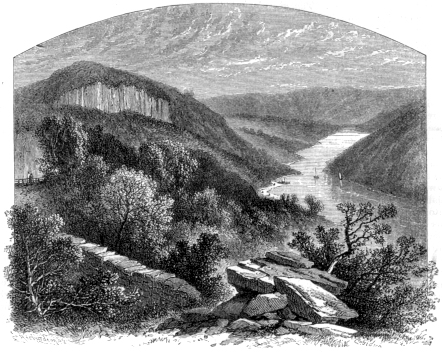|
|
On The Welsh Border.,
Page 7 of 14  The Wynd Cliff.
scribed) and Raglan and Oystermouth and Monmouth, and I know not how many castles more, and Tinteru Abbey besides. All these he props and mends constantly, so that they shall fall to no further decay, during his life at least.
Chepstow is a pleasant old town, once a more considerable place than now. The streets are quaint and hilly, and wind about in strange fashion. There is an old church which was founded in the reign of King Stephen, and was a cell to the abbey of Corneille, in Normandy. The ashes of Marten the regicide lie under a stone in one of the aisles. The old Roundhead was buried in the chancel originally, but a bigoted vicar, whose name was Chest, caused the remains to be removed further off. On this personage an epitaph was written by his son-in-law in these somewhat irreverent words: “Here lies at rest, I do protest,
One Chest within another; The chest of wood was very good Who says so of the other?” Upon the stone which covers Marten’s grave is an inscription, in the shape of an acrostic, written by the regicide himself, which some have criticised as not being poetry of a high order. But then I never heard that Marten laid claim to be considered a poet at all. Two miles from Chepstow you pass the quaint old church of St. Arven’s, where you may rest, if you are tired, at a cozy road-side inn, kept, to all outward appearance, solely by a woman and a little girl. And standing in the grave-yard of St. Arven‘s, with the perfection of beautiful cultivated and hedge-rowed fields all about you, yonder in the distance looms before you a scene whose grandeur is almost worthy to be mentioned in the same breath with the Yosemite Valley. Indeed, as I look upon it I can almost believe myself standing once more on that rugged precipice which overlooks the mighty valley in the Sierras at whose, bottom winds the silver stream of the Merced. It is the Wynd Cliff! “What a cathedral is among churches,” wrote the antiquary Fosbroke, many years ago, “the Wynd Cliff is among prospects.” But the cathedral will still possess the stronger charm for the lover of antiquity, though its hoary walls are youthful in comparison with the everlasting hills. The region round about the Wynd Cliff is thick with the haunts of legend. There is a story for almost every rock in the whole five miles that lie between Chepstow and Tintern Abbey. Some of these are of the battles which have been fought along this border, as the legend of Wyntour’s Leap — a precipice on which was fought one of the fiercest struggles of the civil war, and over which Sir John Wyntour was forced on horseback into the river below. But the preponderance of local story shows plainly the influence of the grand old abbey whose splendid ruins we are approaching — Tintern — where the white-robed Cistercian monks |
|
7
Books & articles appearing here are modified adaptations
from a private collection of vintage books & magazines. Reproduction of these pages is prohibited without written permission. © Laurel O'Donnell, 1996-2006.
|
|

